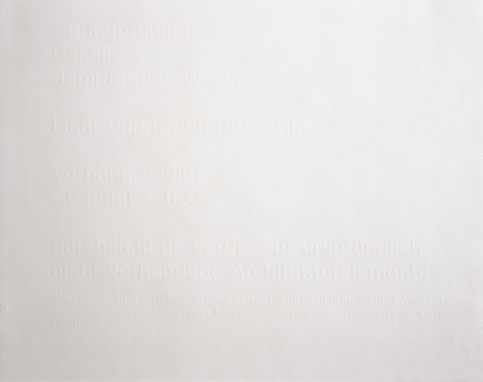Wandbeschriftung Nr. 4

Maria Eichhorn
Wandbeschriftung Nr. 4, 1992
Wall text "Fountain / Basin / steaming Water / Light Through Colored Glass / Curtain (White) / Standing Desk + Text / transparent Color* on originally inexistent / architectural elements / *white as black are both non-transparent, white water / you will not be able to imagine, like what is pure and / like imaging clear milk" in bas-relief: white wall paint on white wall, manual application with brush in several layers, typeface Helvetica Medium, 70 mm/40 mm Total dimensions approx. 154 x 189 cm The language of the wall text is chosen according to the place of exhibition.
GF0000281.00.0-1995
Artwork text
Since 1989, Maria Eichhorn has been examining perception and language as an expression of social relation-ships by means of wall texts in the form of multilayered monochrome reliefs painted in the color of the wall. The text work enters into a dialogue with readers, challenging their perception and interpretation. The text can only be seen and read at very close proximity and in good lighting. According to the artist, this form of presentation gives her a chance “to show something that is not visually conspicuous. They are visible when you want to see them and invisible when you do not want to see them.” Wall Inscription No. 4 was created for the group exhibition mixed doubles, organized in 1992 in the Vienna Se-cession by the Generali Foundation, which at the time was on its way to becoming an independent art institution. Besides Maria Eichhorn, the artists Marcus Geiger, Bethan Huws, and Harmut Skerbisch were also invited to create works for the exhibition—two female and two male artists, two foreign and two Austrian. In Wall Inscription No. 4, several potential works are proposed for the exhibition; the work itself represents the proposal that was finally carried out. The work refers playfully to another of the artist’s works, Curtain (1989-2001), by including the work Curtain (white) in the text. The text does not seem to allow any translation of its descriptions into the object, employing paradoxical elements such as “originally non-existent architectural ele-ments,” while the “transparent paint” also suggests the camouflage of the white text on the same-colored back-ground. In the final footnote, a quote from Ludwig Wittgenstein’s Comments on Color, Maria Eichhorn connects her work to Wittgenstein’s philosophy of language, perception, and the relationship between an object, its name, and the viewer/speaker. In so doing, she also recalls Wittgenstein’s connection to the Secession: his father played an important role in financing it. (Monika Vykoukal)